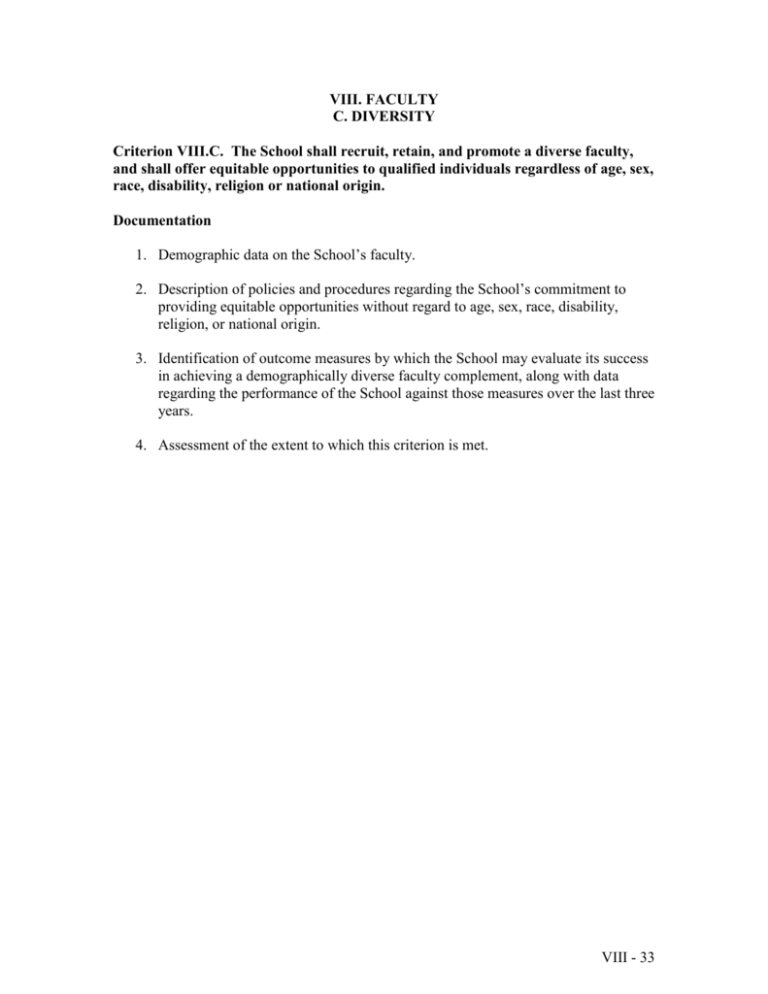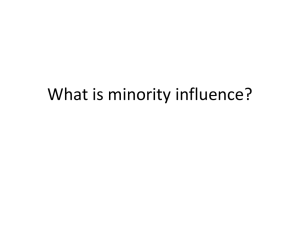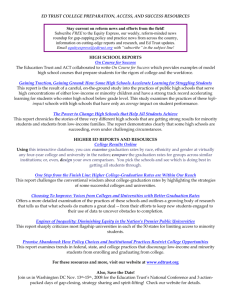C. Diversity - Columbia University
advertisement

VIII. FACULTY C. DIVERSITY Criterion VIII.C. The School shall recruit, retain, and promote a diverse faculty, and shall offer equitable opportunities to qualified individuals regardless of age, sex, race, disability, religion or national origin. Documentation 1. Demographic data on the School’s faculty. 2. Description of policies and procedures regarding the School’s commitment to providing equitable opportunities without regard to age, sex, race, disability, religion, or national origin. 3. Identification of outcome measures by which the School may evaluate its success in achieving a demographically diverse faculty complement, along with data regarding the performance of the School against those measures over the last three years. 4. Assessment of the extent to which this criterion is met. VIII - 33 VIII.C.1. Demographic data on the School’s faculty. Section VIII.A.2 and Table VIII.A.2 provided data for the past three years on the following: total faculty, faculty by department, rank, clinical title, joint appointment, and highest degree. This section focuses on faculty diversity by gender and by race/ethnicity. Gender Table VIII.C.1.a presents data on faculty composition and rank by gender for 1995 (the year of the last accreditation review), and for each of the last three years (2000-2002). At present, women constitute 51% of the faculty. That percentage has remained relatively constant since 1995 when women constituted 49% of the faculty. Columbia is one of an extremely small set of accredited schools of public health that has achieved parity in the number of men and women on the faculty. However, despite substantial progress since the last accreditation review, women remain underrepresented at the highest faculty ranks and among tenured faculty. Table VIII.C.2.a presents the percentage of women in each rank. Women presently constitute 41% of the professor/senior research scientist rank, up from 26% in 1995. The comparable percentages for the other ranks are: associate professor/research scientist rank (1995 = 56%, 2002 = 42%); assistant professor/associate research scientist rank (1995 = 59%, 2002 = 62%). Tenure status by gender also is shown in the table. Women still represent the minority of the tenured faculty (28%), however the percentage has improved—up from 19%—since 1995. Among the faculty members on the tenure track, 53% are women. It should be noted that the demographic composition of the total tenured and senior faculty changes very slowly because once faculty members are promoted into a tenured or a senior position they tend not to leave these positions rapidly. The present composition of the senior faculty is heavily influenced by the actions of the last two decades. More recent promotion and tenure actions provide a better indicator of the School’s current success in developing a diverse faculty. We present two related approaches to examining the recent actions and faculty changes: a comparison of the number of men and women who have achieved tenure since the last accreditation, and the net change, since the last accreditation, in the number of number of men and women who hold tenure positions. The former measure just focuses on movement into the tenure category, whereas the latter measure takes into account both movements into and out of tenure (movement to another university, retirement, etc.) by gender. Focusing first on the tenure decisions since the last accreditation, parity has not been achieved between men and women, but greater equity has been achieved than was true in the past. Of the 16 additional faculty members who have achieved tenure, 7 (44%) were women and 9 were men. VIII - 34 TABLE VIII.C.1.a Faculty Rank by Gender 1995 and 2000-2002 Total Faculty % Female Faculty Rank Professor/Senior Res Scientist % Female Associate Prof/ Research Scientist % Female Assistant Prof/ Assoc. Research Scientist % Female Tenure Status Tenured Faculty % Female Tenure Track Faculty % Female 1995 2000 2001 2002 49% 51% 49% 51% 26% 37% 39% 41% 56% 44% 44% 42% 59% 67% 60% 62% 19% 27% 26% 28% 64% 50% 50% 53% VIII - 35 Turning to the measure of net change by gender, although 16 new faculty achieved tenure, 9 faculty members, who had held tenure, left that category (due to relocations, retirements, and deaths), resulting in a net increase of 7 tenured faculty members. The net number of tenured women increased by 5 and the net number of men increased by 2. These analyses indicate that since the last accreditation the School has continued to improve the number and proportion of women in tenured positions. A “net change” analysis, since the last accreditation, also was conducted with all faculty members at the highest academic rank, Professor/Senior Research Scientist. This change includes a larger group because it includes both tenured and nontenured faculty. There has been a net increase of 25 additional people at this rank since the last accreditation— the number of women at the highest rank has increased by 16 and the number of men by 9. As a result, since the last accreditation the School has increased the number and proportion of women at the Professor/Senior Research Scientist rank. Women hold a number of the significant leadership positions in the School. Two of the School’s 6 Department Chairs are women, and 8 of the School’s 15 Center Directors are women. Among the School’s 7 Deans with functional responsibilities, 4 are women: 1 Vice Dean; 1 Associate Dean; and 2 Assistant Deans. Race/Ethnicity The distribution of the faculty by race/ethnicity is presented in Table VIII.C.1.b. At present there are 50 minority faculty members, up from 20 at the time of the last accreditation. As a result, minority faculty members now comprise 23% of the total, up from 12% in 1995. The number of black faculty members has increased from 10 to 13, but due to the growth of the total faculty the proportion of black faculty remained constant at 6%. There have been greater increases in the number of Hispanic and Asian faculty. The number of Hispanic faculty has increased from 2 to 11, moving from 1% to 5% of the faculty complement. The number of Asian faculty members has increased from 8 to 26, moving from 5% to 12% of the faculty. At the time of the last self study for accreditation, the School decided to embark on a strategy of giving priority to the recruitment of minority junior faculty, including the School’s minority doctoral graduates. Lesser focus was given to the external recruitment of minority senior faculty members, because the pool of available minority faculty at the senior level was perceived to be small. Moreover, the School believed that the strategy of bringing new minority junior faculty into public health would do more to enhance the diversity of the field of academic public health, than would the recruitment of senior minority faculty from our peer Schools. An important component to our strategy of hiring minority junior faculty is the training of increasing numbers of minority doctoral students as described in Criterion IX.B. The School has succeeded in its strategy and both the positive and negative outcomes of that strategy are described below—the School actively sought to increase its complement of minority junior faculty and did so, but it gave lesser focus to the directed recruitment of senior minority faculty and those numbers have increased more slowly. VIII - 36 Table VIII.C.1.b Faculty Rank by Race/Ethnicity 1995 and 2000-2002 1995 2000 2001 2002 88% 6% 1% 5% 81% 5% 4% 9% 78% 5% 5% 12% 77% 6% 5% 2% 95% 5% 0 0 92% 2% 2% 5% 91% 2% 3% 5% 90% 2% 3% 5% 90% 0 7% 4% 89% 4% 0% 7% 88% 4% 0% 8% 88% 4% 0% 8% 82% 7% 3% 8% 68% 9% 8% 15% 63% 9% 9% 20% 64% 9% 8% 18% Tenure Status Tenured Faculty % White % Black % Hispanic % Asian 91% 3% 0 6% 90% 0 0 10% 90% 0 0 10% 90% 0 0 10% Tenure Track Faculty % White % Black % Hispanic % Asian 84% 0 4% 12% 68% 12% 9% 12% 57% 12% 12% 19% 58% 13% 11% 18% Total Faculty % White % Black % Hispanic % Asian Faculty Rank Professor/Senior Res Scientist % White % Black % Hispanic % Asian Associate Prof/ Research Scientist %White % Black % Hispanic % Asian Assistant Prof/ Assoc. Research Scientist % White % Black % Hispanic % Asian VIII - 37 Race/ethnicity by faculty rank and tenure status are shown in Table VIII.C.1.b. The School’s minority faculty members are underrepresented at the senior ranks. Although the percentage of minority faculty at the full professor/senior research scientist rank has doubled since the last accreditation, from 5% to 10%, it is still very low. The 10% minority faculty at this rank are distributed as follows: 2% black; 3% Hispanic; and 5% Asian. Overall, since the last accreditation there has been a net increase of 16 faculty members at the highest rank, and 25% (4 of the 16) were minority faculty. The greatest increase in minority numbers has been at the Assistant Professor/Associate Research Scientist rank. Overall, there has been a net increase of 28 Assistant Professors since the last accreditation—82% (23 of the 28) were minority. As a result, the percentage of minority assistant professors has increased from 18% to 46%. The net numerical increases by group were as follows: black, 5 to 9; Hispanic, 2 to 9; Asian, 6 to 18. The percentage of minority faculty in each group increased as follows: black, 7% to 9%; Hispanic, 3% to 9%; Asian, 8% to 18%. The School has not been successful in increasing the proportion of minority tenured faculty members: 90% of the 39 tenured faculty members are white and 10% are Asian. However, consistent with the above strategy of prioritizing the hiring of junior minority faculty, there has been a net increase of 20 tenure track faculty and 75% (15 of the 20) are minority. Among the 45 faculty members on the tenure track, 42% are minority: black, 13%; Hispanic, 11%; and Asian, 18%. Minorities hold a number of the significant leadership positions in the School. Two of the School’s 15 Center Directors are black. Among the School’s 7 Deans with functional responsibilities, 1 Vice Dean and 1 Associate Dean are black. In sum, the School has achieved its primary objective of increasing the number of minority junior faculty who hold faculty appointments. Increasing the number of minority senior faculty has progressed more slowly. The school needs to continue to be vigilant, in order to ensure that the current cohort of minority junior faculty have opportunities for promotion. VIII - 38 VIII.C.2. Description of policies and procedures regarding the School’s commitment to providing equitable opportunities without regard to age, sex, race, disability, religion, or national origin. Columbia University and the School adhere to a policy of affirmative action and equal opportunity employment. The University’s Statement of Nondiscriminatory Policies is included in the Faculty Handbook (Appendix, VIII.B.1.a, which is also available to the University and the public on the Columbia website, www.columbia.edu/cu/vpaa/fhb. The University Affirmative Action Policy is as follows: “Columbia University has maintained a long-standing commitment to the principle and practice of equal opportunity wherein all personnel actions are taken without discrimination based on race, color, religion, sex, age, national or ethnic origin, sexual orientation, citizenship status, marital status, disability, or status as a Vietnam era or disabled veteran. Through adherence to this commitment, Columbia endeavors to promote diversity and to put opportunity within the reach of all.” The primary mechanism, to ensure that the affirmative action policies are implemented, is the Affirmative Action and Administration Monitoring Committee. The Committee reviews the advertisement, recruitment, search and selection process for all candidates for officer level positions, including all faculty members and officers of administration. In its review the committee ensures that established procedures were followed, and that all “special status” candidates have been given special consideration. No officer level offer of employment may be made without the prior review and concurrence of the Monitoring Committee. A description of the standards and guidelines of the monitoring committee is available at: www.columbia.edu/cu/vpaa/eoaa/docs/hs_aapolicy.html. VIII.C.3. Identification of outcome measures by which the School may evaluate its success in achieving a demographically diverse faculty complement, along with data regarding the performance of the School against those measures over the last three years. The School regularly monitors the number and proportion of women and minority faculty members, for the School as a whole and by rank. The School’s performance on these outcome measures for the year of the last accreditation (1995), and for the past three years (2000-2002) was detailed in Criterion VIII.C.1. We strive to attain parity among male and female faculty members. This goal has been achieved for the total faculty complement—women constitute 51% of the faculty. We are one of very few accredited Schools to achieve this goal. We also strive to attain equal representation of men and women both by faculty rank and tenure status. While the School has made substantial progress since the last accreditation, women remain underrepresented at the highest faculty rank and among tenured faculty. Since the last accreditation women have moved from 19% to 28% of the 39 tenured VIII - 39 faculty members. In that interval there was a net increase of 7 tenured faculty members—5 women and 2 men. Focusing on faculty members at the highest rank (Professor/Senior Research Scientist), regardless of tenure status, women have moved from 26% to 41% of this rank. Since the last accreditation there was a net increase of 25 faculty members at this rank—the number of women had a net increase of 16, and the number of men had a net increase of 9. The School continues to improve the number and proportion of women at the highest ranks, but further diligence is needed to continue the momentum toward parity by rank and tenure status. The School strives to increase the number and proportion of minority faculty members. As presented in Criterion VIII.C.1, since the last accreditation the School has increased the number of minority faculty from 20 to 50. As a result, the percentage of minority faculty has increased from 12% to 23%. The net increase in number of minority faculty was distributed as follows: black, 3; Hispanic, 9; Asian, 18. Criterion VIII.C.1, also described the School’s strategy and rationale for giving priority to the recruitment of minority junior faculty, and giving lesser focus to the directed recruitment of senior minority faculty. One outcome of this strategy is that at the senior and tenure ranks, minority faculty members, particularly black and Hispanic faculty, remain underrepresented. Of the 39 tenured faculty members, 10% are Asian, but none are black or Hispanic. Among faculty at the highest rank (Professor/Senior Research Scientist), regardless of tenure status, the percentage minority increased from 5% to 10% (black, 2%; Hispanic, 3%; and Asian, 5%), but remains low. The School, however, has succeeded in achieving its primary goal of increasing the number and percentage of minority junior faculty. Since the last accreditation there was a net increase of 28 Assistant professors—and 82% (23 of the 28) were minority, as a result the percentage of minority assistant professors increased from 18% to 46%. Similarly among faculty members on the tenure track, 42% are minority (black, 13%; Hispanic, 11%; Asian, 18%). VIII.C.4. Assessment of the extent to which this criterion is met. The School is proud of the fact that it has achieved parity in the number of male and female faculty members. Women remain underrepresented at the highest rank and among tenured faculty, but there has been substantial positive momentum toward parity by rank. The School’s strategy of focusing on enhancing the number of minority junior faculty has succeeded. Among all Assistant Professors the percentage minority has increased from 18% to 46%, with each racial and ethnic minority group showing substantial gains. However, by not focusing on the targeted recruitment of senior minority faculty, progress in this category increased at a much slower rate. VIII - 40 As described in Criterion X.B., the above data were discussed at a special break out session at the faculty retreat. Attention was given to enhancing the ability of junior faculty, including minority junior faculty, to thrive at the School. These discussions also focused on the costs and benefits of the current minority recruitment strategy, and whether the School should expand its strategy to include the targeted recruitment of senior minority faculty. Retreat participants directed the recently reestablished diversity committee, chaired by the Dean, to make recommendations about how the School should proceed. The School perceives that this criterion is met. VIII - 41







